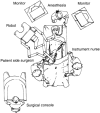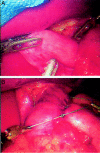Robotic surgical training in an academic institution
- PMID: 11573041
- PMCID: PMC1422071
- DOI: 10.1097/00000658-200110000-00007
Robotic surgical training in an academic institution
Abstract
Objective: To detail robotic procedure development and clinical applications for mitral valve, biliary, and gastric reflux operations, and to implement a multispecialty robotic surgery training curriculum for both surgeons and surgical teams.
Summary background data: Remote, accurate telemanipulation of intracavitary instruments by general and cardiac surgeons is now possible. Complex technologic advancements in surgical robotics require well-designed training programs. Moreover, efficient robotic surgical procedures must be developed methodically and safely implemented clinically.
Methods: Advanced training on robotic systems provides surgeon confidence when operating in tiny intracavitary spaces. Three-dimensional vision and articulated instrument control are essential. The authors' two da Vinci robotic systems have been dedicated to procedure development, clinical surgery, and training of surgical specialists. Their center has been the first United States site to train surgeons formally in clinical robotics.
Results: Established surgeons and residents have been trained using a defined robotic surgical educational curriculum. Also, 30 multispecialty teams have been trained in robotic mechanics and electronics. Initially, robotic procedures were developed experimentally and are described. In the past year the authors have performed 52 robotic-assisted clinical operations: 18 mitral valve repairs, 20 cholecystectomies, and 14 Nissen fundoplications. These respective operations required 108, 28, and 73 minutes of robotic telemanipulation to complete. Procedure times for the last half of the abdominal operations decreased significantly, as did the knot-tying time in mitral operations. There have been no deaths and few complications. One mitral patient had postoperative bleeding.
Conclusion: Robotic surgery can be performed safely with excellent results. The authors have developed an effective curriculum for training teams in robotic surgery. After training, surgeons have applied these methods effectively and safely.
Figures






References
-
- Bonchek LI, Ullyot DJ. Minimally invasive coronary bypass: a dissenting opinion. Circulation 1998; 98: 495–497. - PubMed
-
- Lytle BW. Minimally invasive cardiac surgery [editorial; comment]. J Thorac Cardiovasc Surg 1996; 113: 554–555. - PubMed
-
- Cooley DA. Antagonist’s view of minimally invasive heart valve surgery. J Card Surg 2000; 15: 3–5. - PubMed
-
- Felger J, Chitwood WR Jr, Nifong LW, et al. Evolution of mitral valve surgery: toward a totally endoscopic approach. Ann Thorac Surg (in press). - PubMed
-
- Felger J, Nifong LW, Chitwood WR Jr. Robotic valvular surgery. Curr Opinion Cardiol 2001; 15: 146–151. - PubMed
Publication types
MeSH terms
LinkOut - more resources
Full Text Sources
Medical
Miscellaneous

